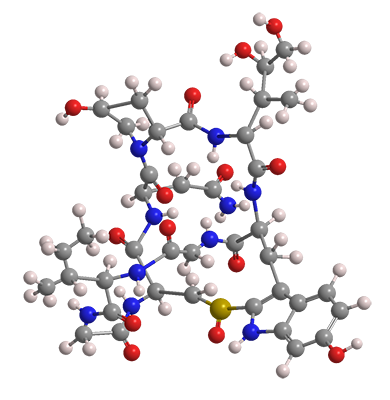What molecule am I?


α-Amanitin, along with its relatives β-, γ-, and ε-amanitin, are highly toxic cyclic peptides produced by species of the mushroom genus Amanita. The most notorious of these fungi is the so-called “death cap”, Amanita phalloides. α-Amanitin is considered to be the deadliest of the death-cap poisons. It has been estimated that A. phalloides accounts for 90% of mushroom-ingested fatalities worldwide.
The amanitins are unusual peptides in that
- the amino acid chain is branched;
- the branching gives rise to an inner loop; and
- they are biosynthesized on ribosomes.
α-Amanitin’s toxicity derives from its ability to inhibit RNA polymerases II and III. Experiments to establish the chemical nature of the amanitins began in the 1900s, but their structures and properties were not described until the early 1940s by work in the laboratories of Heinrich Otto Wieland (the 1927 chemistry Nobelist) and later his son Theodor*.
Ever since the Wielands’ work, chemists have tried to develop a total synthesis of α-amanitin. This year, it finally happened. David M. Perrin and colleagues at the University of British Columbia (Vancouver) overcame three major impediments to complete the outer ring, the inner ring, and the correct stereochemical placement of the sulfoxide group on the way to producing the molecule.
This synthesis is important because medical researchers require sufficient quantities of α-amanitin to create antibody–drug conjugates made from it. Some of the conjugates have shown promise as anticancer agents.
*The Wielands were quite the chemistry family. Heinrich’s father, also named Theodor, was a pharmaceutical chemist, as was his son Wolfgang. Another son, Otto, was a professor of medicine. His daughter Eva married biochemist Feodor Lynen who won the Nobel Prize in physiology or medicine in 1964.
α-Amanitin fast facts
| CAS Reg. No. | 23109-05-9 |
| Molar mass | 918.97 g/mol |
| Empirical formula | C39H54N10O14S |
| Appearance | White to light yellow needles |
| Melting point | 254–255 ºC |
| Water solubility | ≈1–10 g /L |
α-Amanitin hazard information
| GHS classification**: acute toxicity, oral, category 1 | |
| H300—Fatal if swallowed | |
| GHS classification: specific target organ toxicity, repeated exposure, category 2 | |
| H373—Causes damage to organs through prolonged or repeated exposure. | |
**Globally Harmonized System of Classification and Labeling of Chemicals. Explanation of pictograms.

Learn more about this molecule from CAS, the most authoritative and comprehensive source for chemical information.
Molecule of the Week needs your suggestions!
If your favorite molecule is not in our archive, please send us a message. The molecule can be notable for its current or historical importance or for any quirky reason. Thank you!
Stay Ahead of the Chemistry Curve
Learn how ACS can help you stay ahead in the world of chemistry.

